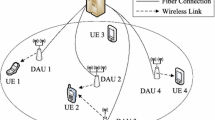Abstract
This paper address the energy conservation issues in wireless downlink of mobile networks with distributed antenna transmission. From the basic information theory for MIMO channels, we derived a simple energy efficiency defined as number of bits per Watt. we then identified three approaches to improve the optimal energy efficiency with a higher capacity, which include alleviating channel fading loss, mitigating the interference, and increasing the number of antennas. We considered the scenario of a single cell with distributed antennas to jointly investigate above three factors. We first proposed a beamforming based energy-efficient resource allocation algorithm, which can achieve the optimal energy efficiency with a higher capacity through adaptively allocating resources and managing interferences. Due to the computational complexity of this algorithm and real-time processing requirement, we further proposed a low-complexity antenna-selection based resource allocation algorithm, which is more tractable and only with slightly performance loss. Finally, we compared different network configurations with these algorithms by extensive simulations, the results demonstrate that the proposed algorithms in distributed antenna configurations achieve better energy efficiency at a high operational throughput point.






Similar content being viewed by others
References
3GPP TR 32.826 (2010) Telecommunication management; study on energy savings management (ESM). Rel 10
Correia LM, Zeller D, Blume O, Ferling D, Jading Y, Godor I, Auer G, Van Der Perre L (2010) Challenges and enabling technologies for energy aware mobile radio networks. IEEE Commun Mag 48(11):66–72
EARTH (Energy Aware Radio and neTwork tecHnologies). https://www.ict-earth.eu
Nguyen K, Ji Y (2010) AM-MAC: an energy efficient, Adaptive Multi-hop MAC protocol for sensor networks. In: Proceedings of the 6th International Wireless Communications and Mobile Computing Conference, pp 432–436 ACM
Gu Y, Ji Y, Zhao B (2009) Maximize lifetime of heterogeneous wireless sensor networks with joint coverage and connectivity requirement. In: Scalable computing and communications; Eighth international conference on embedded computing, 2009. International Conference on SCALCOM-EMBEDDEDCOM’09, IEEE, pp 226–231
Chen M, Kwon T, Yuan Y, Choi Y, Leung V (2007) Mobile agent-based directed diffusion in wireless sensor networks. EURASIP J Appl Signal Process 2007(1):219
Chen M, Leung VCM, Mao S, Kwon T (2009) Receiver oriented load-balancing and reliable routing in wireless sensor networks. Wirel Commun Mob Comput 9(3):405–416
Kim H, de Veciana G (2010) Leveraging dynamic spare capacity in wireless systems to conserve mobile terminals’ energy. IEEE/ACM Trans Netw 18(3):802–815
Cui S, Madan R, Goldsmith AJ, Lall S (2007) Cross-layer energy and delay optimization in small-scale sensor networks. IEEE Trans Wirel Commun 6(10):3688–3699
Belmega EV, Lasaulce S (2009) An information-theoretic look at MIMO energy-efficient communications. In: Proceedings of the fourth international ICST conference on performance evaluation methodologies and tools. ICST (Institute for Computer Sciences, Social-Informatics and Telecommunications Engineering), pp 1–10 (2009)
Kelif JM, Coupechoux M, Marache F (2010) Limiting power transmission of green cellular networks: impact on coverage and capacity. In: 2010 IEEE international conference on communications (ICC). IEEE, pp 1–6
Paulraj A, Nabar R, Gore D (2003) Introduction to space-time wireless communications. Cambridge University Press
Roh W, Paulraj A (2002) Outage performance of the distributed antenna systems in a composite fading channel. In: 2002 IEEE 56th vehicular technology conference. Proceedings. VTC 2002-fall, vol 3. IEEE, pp 1520–1524
Gan J, Li Y, Zhou S, Wang J (2007) On sum rate of multi-user distributed antenna system with circular antenna layout. In: 2007 IEEE 66th vehicular technology conference. VTC-2007 Fall. IEEE, pp 596–600
Clark MV, Willis III TM, Greenstein LJ, Rustako Jr AJ, Erceg V, Roman RS (2002) Distributed versus centralized antenna arrays in broadband wireless networks. In: IEEE VTS 53rd vehicular technology conference, 2001. VTC 2001 spring, vol 1. IEEE, pp 33–37
Choi W, Andrews JG (2007) Downlink performance and capacity of distributed antenna systems in a multicell environment. IEEE Trans Wirel Commun 6(1):69–73
Zhang J, Andrews J (2008) Distributed antenna systems with randomness. IEEE Trans Wirel Commun 7(9):3636–3646
Dai H, Zhang H, Zhou Q (2007) Some analysis in distributed MIMO systems. J Commun 2(3):43
Wang D, You X, Wang J, Wang Y, Hou X (2008) Spectral efficiency of distributed MIMO cellular systems in a composite fading channel. In: IEEE international conference on communications, 2008. ICC’08. IEEE, pp 1259–1264
Park J, Song E, Sung W (2009) Capacity analysis for distributed antenna systems using cooperative transmission schemes in fading channels. IEEE Trans Wirel Commun 8(2):586–592
Zhong L, Ji Y, Gong M, Liu F (2010) Interference mitigation for distributed MIMO cellular systems using cooperative beamforming. In: Proceedings of the 6th international wireless communications and mobile computing conference. ACM, pp 1060–1064
Trigui I, Laourine A, Affes S, Stéphenne A (2009) Outage analysis of wireless systems over composite fading/shadowing channels with co-channel interference. In: Wireless communications and networking conference, 2009. WCNC 2009. IEEE, pp 1–6
Dai H, Molisch AF, Poor HV (2004) Downlink capacity of interference-limited MIMO systems with joint detection. IEEE Trans Wirel Commun 3(2):442–453
Goldsmith A (2005) Wireless communications. Cambridge University Press
Jorswieck EA, Larsson EG, Danev D (2008) Complete characterization of the Pareto boundary for the MISO interference channel. IEEE Trans Signal Process 56(10):5292–5296
Viswanath P, Tse DNC, Laroia R (2002) Opportunistic beamforming using dumb antennas. IEEE Trans Inf Theory 48(6):1277–1294
Author information
Authors and Affiliations
Corresponding author
Rights and permissions
About this article
Cite this article
Zhong, L., Ji, Y. & Yang, K. Energy-Efficient Resource Allocation in Mobile Networks with Distributed Antenna Transmission. Mobile Netw Appl 17, 36–44 (2012). https://doi.org/10.1007/s11036-011-0306-6
Published:
Issue Date:
DOI: https://doi.org/10.1007/s11036-011-0306-6




